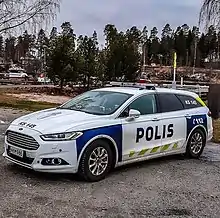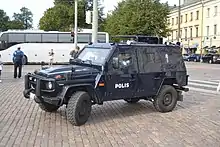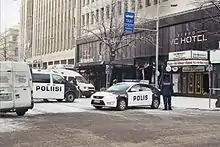Police of Finland
The Police of Finland (Finnish: Poliisi, Swedish: Polis) is a national government agency responsible for general police and law enforcement matters in Finland. The Police of Finland is subordinate to the Ministry of the Interior and consists of the National Police Board (Finnish: Poliisihallitus, Swedish: Polisstyrelsen), two national police units and 11 local police departments.[1]
| Police of Finland Poliisi/Polis | |
|---|---|
 The head of lion from the Finnish coat of arms and the sword emblem is the symbol of the Police of Finland | |
| Jurisdictional structure | |
| Operations jurisdiction | Finland |
| Operational structure | |
| Headquarters | Helsinki |
| Parent agency | Ministry of Interior |








On October 1, 2003, the Public Order Act went into effect, standardizing public ordinances throughout the country.[2]
Local police departments
The police is divided into police departments, which encompass the area of multiple municipalities; municipalities do not have police forces of their own. The function of each police department is to maintain general law and order, prevent crime, investigate crime and other events that threaten public order and safety, to carry out traffic control and surveillance and promote traffic safety, and perform all other duties prescribed by law or otherwise assigned to the police in their area. Local police departments are organized into uniformed patrol police (Finnish: järjestyspoliisi, literally "order police") and criminal investigation police (Finnish: rikospoliisi, literally "criminal police").
Local police also processes licenses and permits such as gun licenses, national ID cards and passports, and furthermore, enforces immigration decisions by the Finnish Immigration Service. Local police must also be notified when organizing public events that may significantly influence local public security and traffic. Driving licenses have been issued by the local police, but since 2016 by Traficom (Finnish Transport and Communications Agency).[3]
Alarm services are operated by Emergency Response Centres managed by the Ministry of the Interior in cooperation with the Ministry of Social Affairs and Health.[4]
Local police departments as of 2014:[5][6]
- Lapland Police Department (Rovaniemi)
- Central Finland Police Department (headquarters in Tampere)
- Eastern Finland Police Department (Kuopio)
- Eastern Uusimaa Police Department (Vantaa)
- Helsinki Police Department (Helsinki)
- Häme Police Department (Lahti)
- Ostrobothnia Police Department (Vaasa)
- Oulu Police Department (Oulu)
- Southeastern Finland Police Department (Kouvola)
- Southwestern Finland Police Department (Turku)
- Western Uusimaa Police Department (Espoo)
In addition, the Åland Islands has its own police department which falls under the responsibility of the Government of Åland (see law enforcement in Åland).
National police units
The National Bureau of Investigation (Finnish: Keskusrikospoliisi, KRP, Swedish: Centralkriminalpolisen, CKP) is responsible for major criminal investigations and certain types of specialist services such as fingerprint recognition. The NBI was formed in 1954 to assist the country's other police elements in efforts against crime, particularly that of a serious or deeply rooted nature.[7] A special concern of the NBI is white-collar crime. To carry out its mission, the force has advanced technical means at its disposal, and it maintains Finland's fingerprint and identification files. The NBI is not a part of the police, instead it is a separate nationwide law enforcement agency which assists local police with investigations. .[7]
The Police University College (Finnish: Poliisiammattikorkeakoulu, Polamk, Swedish: Polisyrkeshögskolan) in Tampere is responsible for police training, research and development.[8]
The Finnish Security Intelligence Service (Finnish: Suojelupoliisi, Supo, Swedish: Skyddspolisen, Skypo) is responsible for national security and the investigation of related crimes. The Supo was moved directly under the Ministry of the Interior in 2016.[9]
The National Traffic Police (Finnish: Liikkuva poliisi, Swedish: Rörliga polisen) was folded into the local police in 2013, thus local police is also responsible for highway patrol. Originally, local police districts were very small and had limited resources, so a separate mobile police organization was founded for riot control, alcohol law enforcement and reserve force duties. Political reliability and independence from local strongmen was also important because of the threat from fascists; indeed, the first task was to escort former president K.J. Ståhlberg back to his home after he was kidnapped by the Lapua Movement. This organization later evolved into a highway patrol. However, because of mergers, local police departments had become larger. Thus, the separate national organization was deemed redundant and traffic police units were subordinated to the local police departments instead, without change in the actual number of highway patrol officers.
Other nationally active formations
Special Intervention Unit (Finnish: Poliisin valmiusyksikkö), also known as "Bear Squad" (Finnish: "Karhu-ryhmä"), is a specialized armed response unit. It is officially part of the Helsinki Police Department.
In June 2008, the Finnish police established a Police Incident Response Team tasked with improving the prevention, detection and management of serious information security incidents.[10]
Vaativan ajotavan valvonta, also known as VATV- unit is a group of highly trained police officers specialized in high-speed driving and pursuits. The unit holds several unmarked high-performance cars ranging from 280-340 horse powers. [11]
Police ranks
The Finnish police uses the following ranks:[12][13][14]
Criminal investigators prefix their ranks with rikos-, "Detective", literally "Criminal", e.g. rikostarkastaja.
Rank insignia on the shoulder epaulettes is all silver on blue with a silver button. The rank insignia for Senior Constable is a single bar, added with two chevrons for Sergeant. Police officers have bordered rows of oak leaves, with a Lion of Finland next to them. Additionally, on the collar there is pentagonal insignia that always has the emblem with laurel leaves and a border, but with colors slightly varying with rank; officers have a border around the pentagon.
| Group | Officers | ||||||||
|---|---|---|---|---|---|---|---|---|---|
| Insignia |  |
 |
 |
 |
 |
 |
 |
 | |
| Rank | Poliisiylijohtaja Polisöverdirektör |
Poliisijohtaja Polisdirektör |
Poliisipäällikkö Polischef |
Poliisiylitarkastaja Polisöverinspektör |
Apulais-poliisipäällikkö Biträdande polischef |
Poliisitarkastaja Polisinspektör |
Ylikomisario Överkommissarie |
Komisario Kommissarie | |
| English | National police commissioner | Deputy national police commissioners, Police chief of Helsinki, Director of the NBI, Director of the Supo |
Police chief (Regional police departments) | Assistant police commissioners (chief), Deputy assistant police commissioners (expert) |
Deputy police chiefs | Chief superintendents, police legal officers |
Superintendents | Chief inspectors | |
| Group | Non-commissioned officers | Policemen | |||||||
| Insignia |  |
 |
 | ||||||
| Rank | Ylikonstaapeli Överkonstapel |
Vanhempi konstaapeli Äldre konstapel |
Nuorempi konstaapeli Yngre konstapel | ||||||
| English | Police sergeants | Senior constables | Junior constables | ||||||
Equipment
- Glock 17, (is being replaced with Walther P99Q[16])
- Heckler & Koch MP5, (is being replaced with CZ Scorpion Evo 3[17])
- Heckler & Koch G36C
- Taser X26
- FN 303
- CZ Scorpion Evo 3[18]
- Baton
- Pepper spray
- TETRA
- Handcuffs
- Light and heavy armor
Vehicles

The most common patrol vehicle of police in Finland is Volkswagen Transporter, usually with 2.5 l diesel engines. In 2002 about one third of Finnish police cars were Transporters.[19] Transporters are also used by border guards, customs, and sotilaspoliisi (military police). Due to the bilingualism of the country, the right side of the vehicles is marked in Finnish language (POLIISI), the left side is marked in Swedish language (POLIS). The siren used for the Finnish police cars are also used for the police of Sweden.
Current vehicles of the Finnish police
- Ford Kuga (unmarked)
- Ford Focus (unmarked police cars)
- Audi A8 (unmarked)
- Mercedes-Benz E-class (unmarked units in Helsinki. Used mostly as escort cars
- BMW 7 series (used mostly as unmarked escort cars for the President of Finland)
- Citroën Berlingo (used as mobile speed camera units in Helsinki)
- Ford Mondeo (2012–2018 models)
- Ford Ranger (unmarked, in use in Helsinki)
- Ford Transit (used as material transport by Espoo department and one in Kristinestad, used also by Bear Squad)
- Opel Vectra (not in use, stored as reserve vehicles)
- Opel Movano (unmarked, used by Pohjanmaa departments and Bear Squad)
- Škoda Octavia (2013–2018 models, including Skoda octavia VRS and -scout)
- Škoda Superb (2017– models, including Škoda superb sportline)
- Ford Tourneo Connect (used as mobile speed camera cars and also used unmarked in Helsinki)
- Toyota Avensis
- Toyota Corolla Verso (unmarked police cars used in the Helsinki region)
- Mitsubishi Outlander (in use as unmarked backup cars in Helsinki)
- Mitsubishi Pajero (unmarked cars in Helsinki)
- Toyota Land Cruiser (Used by Bear Squad)
- Toyota Hilux (unmarked police cars in Rovaniemi, also used by Bear Squad)
- Toyota Prius (in use at the Turku department)
- Nissan Navara (unmarked police cars, mostly in use for personnel transport in Helsinki)
- Nissan Primastar (unmarked, mostly used as a backup in emergency situations around Helsinki)
- Nissan qashqai (unmarked)
- Volkswagen Passat (regular-, alltrack- and r-line models)
- Volkswagen Caddy (mobile speed camera units and unmarked police cars)
- Volkswagen Tiguan (unmarked police vehicles. Including Vw tiguan r-line)
- Volkswagen Golf Variant (used as unmarked police cars)
- Volkswagen E-Golf (in use in Helsinki)
- Volkswagen Transporter (different variants, for example, K9, office and LGV monitoring units)
- Mercedes-Benz Sprinter (LGV monitoring and riot control capabilities)
- Mercedes-Benz G-Class (used by Bear Squad)
- Mercedes-Benz G280 LAPV Enok (used by Bear Squad)
- Mercedes-Benz CLS
- Volvo V70
- Ford Focus ST
- Mercedes-Benz Vito (2019–) [20]
- Hyundai Ioniq electric (unmarked)
Marked police motorcycles are usually either BMW K1200 RS, Yamaha FJR 1300, Yamaha FZ1, Yamaha XT660, Honda VFR1200 or KTM 1190 Adventure models. Unmarked motorcycles are Yamaha YZF1000R Thunderace- and Yamaha YZF-R1 models. Motorcycles are used in pursuit situations. The quad bikes are also used in service, mostly used are Polaris Sportsman and Can-Am.
Additionally, Finnish police operates snowmobiles, water scooters and boats.[21] Helsinki department also has a mounted police unit.
References
- "Poliisi - Organisation". www.poliisi.fi. Retrieved 18 August 2017.
- Public Order Act Archived 2007-04-17 at the Wayback Machine Retrieved 19 May 2007
- "Poliisi - Ajokortti". www.poliisi.fi. Retrieved 18 August 2017.
- "Etusivu - 112 Hätäkeskuslaitos". www.hatakeskus.fi. Retrieved 18 August 2017.
- "Poliisi - Contact information". www.poliisi.fi. Retrieved 18 August 2017.
- "Archived copy" (PDF). Archived from the original (PDF) on 2015-09-24. Retrieved 2016-09-25.CS1 maint: archived copy as title (link)
- Text from PD source: US Library of Congress: A Country Study: Finland, Library of Congress Call Number DL1012 .A74 1990.
- "Poliisi - Police University College". www.poliisi.fi. Retrieved 18 August 2017.
- "Government advances plan to move Supo to Interior Ministry". Retrieved 18 August 2017.
- "Finnish police sets up IRT". Blog.anta.net. 2008-06-23. ISSN 1797-1993. Retrieved 2008-06-23.
- | url: https://www.iltalehti.fi/autouutiset/a/8b02a208-dd3e-45cd-b1f2-20ef870a61b2
- "FINLEX ® - Säädökset alkuperäisinä: Valtioneuvoston asetus poliisista 1080/2013". www.finlex.fi. Retrieved 18 August 2017.
- "Archived copy". Archived from the original on 2015-02-17. Retrieved 2015-02-17.CS1 maint: archived copy as title (link)
- "Archived copy". Archived from the original on 2014-11-09. Retrieved 2015-02-17.CS1 maint: archived copy as title (link)
- "Sisäministeriön asetus poliisin virkapuvusta (1106/2013), §9". Poliisi. Retrieved 2015-12-30.
- Retrieved 13 April 2013
- Retrieved 7 October 2018
- "Poliisin asearsenaali uusiksi – konepistoolit ja kiväärit menevät vaihtoon, mahdollisesti myös pistoolit". Yle Uutiset (in Finnish). Retrieved 2018-10-07.
- Retrieved 26 March 2014
- Includes pictures of the police vehicles
- Retrieved 26 March 2014
External links
| Wikimedia Commons has media related to Police of Finland. |

